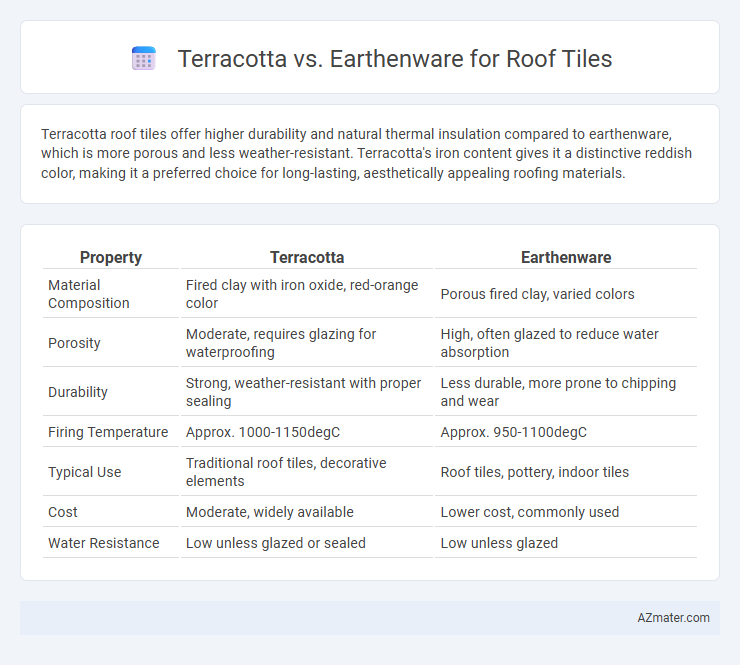Terracotta roof tiles offer higher durability and natural thermal insulation compared to earthenware, which is more porous and less weather-resistant. Terracotta's iron content gives it a distinctive reddish color, making it a preferred choice for long-lasting, aesthetically appealing roofing materials.
Table of Comparison
| Property | Terracotta | Earthenware |
|---|---|---|
| Material Composition | Fired clay with iron oxide, red-orange color | Porous fired clay, varied colors |
| Porosity | Moderate, requires glazing for waterproofing | High, often glazed to reduce water absorption |
| Durability | Strong, weather-resistant with proper sealing | Less durable, more prone to chipping and wear |
| Firing Temperature | Approx. 1000-1150degC | Approx. 950-1100degC |
| Typical Use | Traditional roof tiles, decorative elements | Roof tiles, pottery, indoor tiles |
| Cost | Moderate, widely available | Lower cost, commonly used |
| Water Resistance | Low unless glazed or sealed | Low unless glazed |
Introduction to Terracotta and Earthenware Roof Tiles
Terracotta roof tiles are made from natural clay, fired at high temperatures to achieve durability and a distinctive reddish-brown hue, making them popular for Mediterranean and traditional architectural styles. Earthenware tiles are also crafted from clay but fired at lower temperatures, resulting in a softer, more porous material often used in rustic and historical buildings. Both materials offer excellent thermal insulation and weather resistance, but terracotta's higher firing process generally provides greater strength and longevity for roofing applications.
Material Composition and Manufacturing Processes
Terracotta roof tiles are primarily composed of refined clay mixed with natural iron oxide, fired at high temperatures above 1000degC, resulting in greater durability and a characteristic reddish hue. Earthenware tiles use a coarser clay mixture, often with sand or other additives, and are fired at lower temperatures around 1000degC or below, leading to a more porous and less dense material. The manufacturing process for terracotta involves precise molding and high-temperature kiln firing that enhances strength and weather resistance, while earthenware relies on traditional, less controlled firing that produces more variable tile quality.
Aesthetic Differences: Color and Texture
Terracotta roof tiles exhibit a warm, naturally reddish-brown hue that deepens with age, providing a classic Mediterranean aesthetic. Earthenware tiles come in a broader palette, including earthy browns, muted yellows, and soft reds, allowing greater versatility in design schemes. Texturally, terracotta offers a smooth yet slightly porous surface, while earthenware features a more varied, sometimes rougher finish that adds rustic charm to roofing applications.
Durability and Weather Resistance
Terracotta roof tiles offer superior durability and weather resistance compared to earthenware due to their higher firing temperature, which results in a denser, less porous material. Earthenware tiles, being more porous and fired at lower temperatures, tend to absorb more moisture, making them more susceptible to cracking and weather-related wear over time. The robust nature of terracotta makes it ideal for harsh climates with significant temperature fluctuations and heavy rainfall.
Cost Comparison: Terracotta vs. Earthenware
Terracotta roof tiles generally have a higher upfront cost compared to earthenware due to their refined clay composition and enhanced durability. Earthenware tiles offer a more budget-friendly option but may incur higher maintenance and replacement expenses over time because of their lower resistance to weathering. Considering long-term investment, terracotta provides better cost efficiency despite its initial price premium.
Installation Methods and Ease of Use
Terracotta roof tiles are generally heavier and require a more secure installation method involving battens and nails to ensure stability and durability. Earthenware tiles are lighter and easier to handle during installation, often allowing for quicker placement with simpler fastening techniques such as clip systems or mortar bedding. The ease of use of earthenware makes it a preferred choice for DIY projects or areas with lower structural load capacities.
Energy Efficiency and Insulation Properties
Terracotta roof tiles offer superior thermal insulation due to their dense, porous structure that helps regulate indoor temperatures by absorbing and slowly releasing heat. Earthenware tiles, while similar in composition, typically have lower density and porosity, resulting in less effective insulation and higher heat transfer. The energy efficiency of terracotta roof tiles contributes to reduced cooling and heating costs, making them an optimal choice for sustainable building designs.
Maintenance Requirements and Longevity
Terracotta roof tiles, known for their high durability and natural resistance to weathering, require minimal maintenance, typically involving occasional cleaning and inspections for cracks or chips. Earthenware tiles, while aesthetically similar, tend to be more porous and susceptible to moisture damage, necessitating more frequent sealing and repairs to prevent deterioration. The longevity of terracotta tiles generally exceeds 50 years with proper care, whereas earthenware tiles may last around 25 to 40 years depending on environmental conditions and maintenance practices.
Environmental Impact and Sustainability
Terracotta roof tiles, made from natural clay fired at high temperatures, offer excellent durability and longevity, reducing the need for frequent replacements and minimizing environmental waste. Earthenware tiles, while also clay-based, are fired at lower temperatures, resulting in higher porosity and shorter lifespan, which may increase environmental impact due to more frequent manufacturing and disposal. The energy efficiency in producing terracotta combined with its recyclability enhances its sustainability profile compared to traditional earthenware roofing options.
Choosing the Right Roof Tile: Terracotta or Earthenware
Terracotta roof tiles offer superior durability and natural thermal insulation, making them ideal for climates with varying temperatures, while earthenware tiles provide a more cost-effective option with easier customization in shape and color. Both materials are porous, requiring proper sealing to prevent water absorption and potential damage over time, but terracotta generally outperforms earthenware in longevity and weather resistance. Selecting between terracotta and earthenware depends on budget, aesthetic preferences, and the specific environmental conditions of the installation site.

Infographic: Terracotta vs Earthenware for Roof Tile
 azmater.com
azmater.com